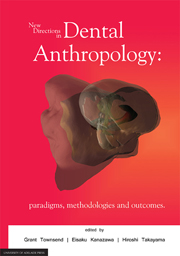Book contents
- Frontmatter
- Foreword
- Contents
- 1 Modelling the complexity of the dentition
- 2 New approaches to dental anthropology based on the study of twins
- 3 Genes for teeth — drawing inference from family data
- 4 Do feeding practices, gestation length, and birth weight affect the timing of emergence of the first primary tooth?
- 5 Sexual dimorphism in the primary and permanent dentitions of twins: an approach to clarifying the role of hormonal factors
- 6 Dental crown and arch size in Europeans and Australian Aboriginals
- 7 Sex determination from maxillary and mandibular canines of the Filipino population
- 8 Non-metric dental characteristics in Papua New Guinea Highlanders and their association with molar reduction
- 9 The Main Occluding Area between opposing teeth during chewing: a comparison between Australians and Japanese
- 10 “Mineral Maintenance” of dental structures in caries and erosive tooth wear: an holistic model
- 11 Emerging techniques for the analysis of tooth wear
8 - Non-metric dental characteristics in Papua New Guinea Highlanders and their association with molar reduction
Published online by Cambridge University Press: 05 May 2013
- Frontmatter
- Foreword
- Contents
- 1 Modelling the complexity of the dentition
- 2 New approaches to dental anthropology based on the study of twins
- 3 Genes for teeth — drawing inference from family data
- 4 Do feeding practices, gestation length, and birth weight affect the timing of emergence of the first primary tooth?
- 5 Sexual dimorphism in the primary and permanent dentitions of twins: an approach to clarifying the role of hormonal factors
- 6 Dental crown and arch size in Europeans and Australian Aboriginals
- 7 Sex determination from maxillary and mandibular canines of the Filipino population
- 8 Non-metric dental characteristics in Papua New Guinea Highlanders and their association with molar reduction
- 9 The Main Occluding Area between opposing teeth during chewing: a comparison between Australians and Japanese
- 10 “Mineral Maintenance” of dental structures in caries and erosive tooth wear: an holistic model
- 11 Emerging techniques for the analysis of tooth wear
Summary
ABSTRACT
A study of non-metric dental traits in people in the Papua New Guinea (PNG) Highlands was carried out and the results were compared with other Asian and Pacific peoples. Dental impressions were obtained of young adults from Kasi village, Wabag, Enga Province, PNG. Frequencies of 13 dental traits were recorded using the Arizona State University Dental Anthropology System. Conspicuous characteristics in PNG Highlanders included: low frequencies of shoveling and double-shoveling of maxillary incisors, 6th cusp in mandibular first molar and Carabelli's trait, but in contrast high frequencies of hypocone reduction in maxillary second molars, 5th cusp in maxillary first molars and 4-cusped mandibular second molars. A principal coordinate plot including 39 Asian and Pacific populations for scores of these 13 traits, based on Smith's MMDs and standard deviations, showed that the PNG Highlanders belonged to the Sunda-Pacific group, but occupied an extreme position on the first axis. Many of dental characteristics of Wabag were related to morphological reduction of the molar dental crowns, especially their distal components. This suggests that their dental morphologies have changed from the original Australian type of dental characteristics to a peculiar type of morphology associated with nutritional conditions and complex genetic factors.
INTRODUCTION
Recent discoveries of archaeological site in highland Papua New Guinea (PNG) demonstrate that this area was colonized by humans almost 49,000 years ago (Gasden, 2010; Summerhays, 2010).
- Type
- Chapter
- Information
- New Directions in Dental AnthropologyParadigms, Methodologies and Outcomes, pp. 92 - 105Publisher: The University of Adelaide PressPrint publication year: 2012



